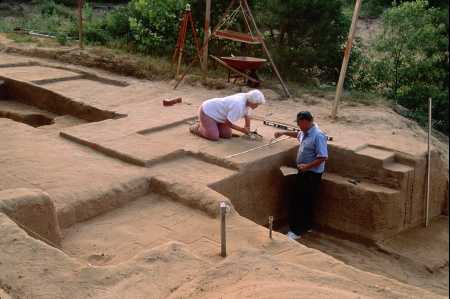 |
PHILADELPHIA (AP) - A campfire story from a Virginia hilltop may settle the granddaddy of all immigration debates - when the first human settlers set foot in America and where they came from. Researchers say laboratory tests show that material from an early human settlement on a sandy slope called Cactus Hill, 45 miles south of Richmond, came from a period thousands of years before humans were thought to be in the Western Hemisphere. The findings may finally force anthropologists to rethink the longstanding image of a wave of skin-clad, spear-carrying humans trudging over a land bridge from Siberia after the last ice age. "The significant thing today is that we're very sure the site exists, that the older level really is there,'' said archaeologist Joseph M. McAvoy, leader of the team presenting its findings in Friday at a conference of the Society for American Archaeology.
 |
Researchers generally agree humans evolved several hundred thousand years ago, possibly in Africa, then spread across Europe and Asia. In the 1930s, a dig near Clovis, N.M., revealed a ``Clovis culture,'' characterized by distinctive spear points and dating back 10,900 to 11,500 years. The culture quickly spread throughout North America. In 1997, a site in Chile called Monte Verde was found to have been occupied 12,500 years ago - 1,000 years earlier than Clovis.
McAvoy has worked since 1989 at Cactus Hill, about 100 yards from the Nottoway River, where Clovis tools had been found. But beneath the Clovis-era site, they found tools of a different material that dated back 15,000 to 17,000 years. Soils scientist James C. Baker of Virginia Tech, with the help of laser dating, provided evidence that older areas of the site had not been polluted by the younger eras. The sand from the site was examined for evidence of disturbance by living material. Lucinda McWeeney, a Yale paleobotanist, used two methods to show that remains of white pine trees matched the time sequence provided by other evidence. Charred bone fragments were identified and believed to have been burned in a hearth rather than a forest fire. The results prove humans occupied the site far earlier than the Clovis era, McAvoy said.
McAvoy said the earlier residents were hunter-gatherers and may have eaten the Eastern mud turtles and whitetail deer, burned remains of which were found. Their presence means the Americas were not populated by a single mass migration, he said. ``The Western Hemisphere was probably populated in spurts, probably starting more than 20,000 years ago, by small groups of nomadic hunters that just came in at various periods of time like opening and shutting the faucet of a sink,'' McAvoy said. ``It wasn't a long significant migration probably until much later.'' Neither McWeeney nor McAvoy believes the research will settle the bitter dispute over the first peoples of America. ``I think it's enough to begin a resolution,'' McWeeney said. ``I don't think it's going to end it.''
Copyright © 2000 The Associated Press. All rights reserved.